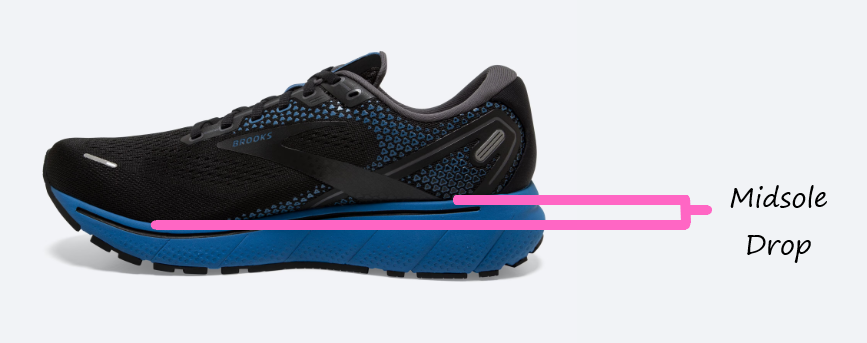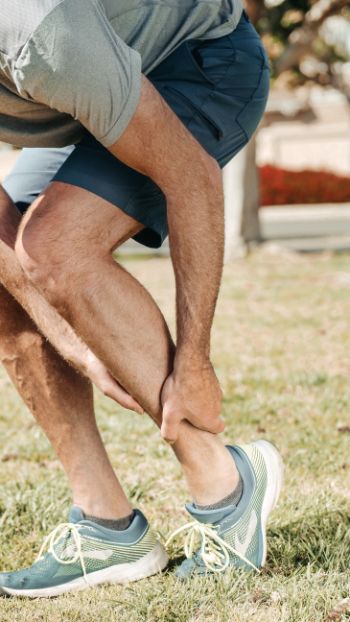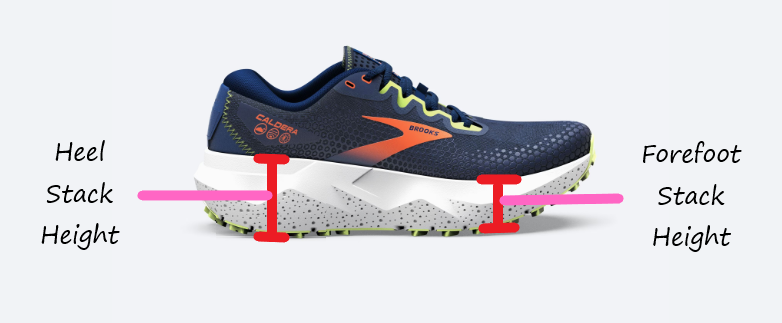What Is Midsole Drop, and Why It Matters?

Have you ever gone for a run and felt like something was just off with your shoes?
Maybe your feet were hurting, your knees were aching, or you couldn’t find your stride. It could be that your shoes didn’t have the right midsole drop.
But what is midsole drop, and why is it so important?
Simply put, midsole drop is the difference in height between the heel and forefoot of your shoe. It can affect everything from your running form to your injury risk. And with so many different types of midsole drops, it can take time to know which one is right for you.
In this blog post, we’ll dive into the world of midsole drop and explore what it is, why it matters, and how to choose the right one for you. So lace up your shoes, and let’s get started!
So, what exactly is midsole drop?

In simple terms, it’s the difference in height between the heel and forefoot of your shoe. It’s measured in millimeters and ranges from 0 mm (zero-drop) to 14 mm and more.
Midsole drop is like the architectural blueprint that determines the slope within the shoe, affecting how your foot lands and moves during each stride.
Think of it this way:
Let’s say you’re comparing two shoes.
Shoe A has a midsole drop of 12 mm, meaning the cushioning under the heel sits 12 mm higher than the cushioning under the forefoot.
On the other hand, Shoe B has a lower midsole drop of 4 mm, indicating a more minimal height difference.
Key Notes
Midsole drop is also referred to as shoe drop, toe drop, ramp angle, heel differential, heel-to-toe drop, HTT drop, pitch, gradient, or shoe offset.
Besides, it’s essential to keep in mind that the term “midsole drop” only refers to the difference in height between the front (forefoot) and back (heel) of the shoe, not the overall thickness of the midsole.
So, even if a shoe has a thick and cushioned midsole, it doesn’t necessarily mean it will have a high drop.
How to calculate Midsole Drop?
Most shoe manufacturers provide information about the drop of their shoes, either on the shoe itself or through a quick online search.
You can look for terms like heel-to-toe drop, midsole drop, heel offset, or shoe drop.
However, if you can’t find this information, here are the steps you can follow to calculate the midsole drop of a shoe on your own:
- Measure the stack height of the heel: Use a ruler or calipers to measure the distance from the ground to the top of the midsole at the heel of the shoe.
- Measure the stack height of the forefoot: Use a ruler or calipers to measure the distance from the ground to the top of the midsole at the forefoot of the shoe.
- Calculate the midsole drop: Subtract the forefoot stack height from the heel stack height to determine the midsole drop. The result will be in millimeters.
For example, if a shoe has a heel stack height of 30mm and a forefoot stack height of 20mm, its midsole drop would be 10mm (30mm – 20mm = 10mm).
You can also watch the following video for another method:
But why does this measurement matter?

Well, think about it this way: when standing barefoot on a flat surface, your heel and forefoot are at the same level. But when you put on a pair of shoes with a high midsole drop, your heel is suddenly elevated above your forefoot.
This can change how your foot strikes the ground when you run, affecting everything from your running form to your injury risk.
Let’s say, for example, that you’re a runner who has always worn shoes with a high midsole drop. You decide to switch to a zero-drop shoe because you’ve heard that it can improve your running form.
At first, everything feels great. But after a few runs, you begin to notice some soreness in your calves and Achilles tendon. This could be because the zero-drop shoe places more stress on these areas than you’re used to.
On the other hand, let’s say you’re a runner who has always struggled with knee pain. You decide to switch from a high-drop shoe to a low-drop shoe and notice an improvement in your symptoms.
This could be because the low-drop shoe promotes a midfoot strike, which can reduce stress on the knees.
How is Midsole Drop Different from Stack Height?

Midsole drop and stack height are two different measurements that are often confused with each other.
Midsole drop, also known as heel-to-toe drop or offset, is the difference in height between the heel and forefoot of a shoe. It is measured in millimeters and can range from 0 to 14 mm or more.
Stack height, on the other hand, refers to the amount of material between the foot and the ground. It is also measured in millimeters and can vary significantly between different shoes. Stack height includes the thickness of a shoe’s midsole, outsole, and insole.
The Impact of Midsole Drop on Foot Mechanics

Alright, now we’re getting to the juicy stuff. Brace yourself as we unravel the fascinating ways midsole drop can influence your foot mechanics.
It’s like a secret power that your shoes hold, affecting how you move and feel with every step.
First off, let’s talk about foot strike patterns.
Picture yourself as a runner on a sunny day, hitting the pavement with determination. With a higher midsole drop shoe, your foot will likely land on the heel first, absorbing the impact as you roll forward. It’s like the shoe takes the lead, guiding your foot from heel to toe.
On the other hand, if you’re wearing a shoe with a lower or zero-drop midsole, your foot tends to strike the ground closer to the midfoot or forefoot.
This landing style encourages a more natural foot motion as if you were running barefoot on a sandy beach. The shoe becomes a companion, allowing your foot to move freely and engaging the muscles and tendons in your arch and forefoot.
Now, let’s talk about cushioning and shock absorption.
When you opt for a higher midsole drop shoe, you’ll likely experience more cushioning under the heel.
This extra padding can be a lifesaver during those long runs or intense workouts, providing a soft landing and reducing the stress on your joints. It’s like having a plush pillow beneath your heel, ready to cushion each step.
On the other hand, lower or zero-drop shoes offer less heel cushioning and a more responsive feel. It’s like connecting directly with the ground, allowing you to feel every little pebble or irregularity.
This can be beneficial if you prefer a more minimalist running experience and want to enhance your proprioception—the body’s ability to sense its position and movement.
Now, let’s not forget about foot stability.
The midsole drop can affect your stability during your runs or walks.
Shoes with a higher midsole drop often provide more inherent stability, especially if you tend to overpronate (when your foot rolls excessively inward). The elevated heel and structured design help guide your foot into a more neutral position, reducing the risk of excessive inward rolling.
Conversely, lower or zero-drop shoes can promote a more natural foot motion and engage the intrinsic stabilizing muscles of your feet and lower legs. They allow your foot’s arch and muscles to work dynamically, contributing to a more active and supportive foot structure.
We shouldn’t ignore the injury risk too!
For example, if you’re a runner with a history of knee pain, switching to a low-drop shoe could help reduce stress on your knees and alleviate your symptoms.
On the other hand, if you’re a runner with a history of plantar fasciitis, switching to a high-drop shoe could help reduce stress on your plantar fascia and improve your symptoms.
So, as you can see, midsole drop isn’t just about numbers and measurements; it’s about how your shoes influence your foot mechanics. It’s about finding that sweet spot that aligns with your running or walking style, goals, and overall comfort.
So, whether you’re looking for cushioned support or a more minimalist experience, understanding the impact of midsole drop is critical. Besides, it is essential to experiment with different drops to see what feels best for you.
Choosing the Right Midsole Drop for Your Activity

Finding the perfect midsole drop that suits your activity like a glove is essential. Remember, the right midsole drop can make all the difference in your running or walking experience.
However, we can’t ignore that no perfect or ideal midsole drop applies to everyone. According to the studies conducted by scientists in Luxembourg, there is no magic formula for the relationship between shoe drop and injury prevention or running performance.
But still, there are tips and techniques to find the most suitable midsole drop for your activity.
Let’s explore the different midsole drop options available.
It’s like being presented with a buffet of shoes, each offering a unique combination of features and benefits. You’ll come across zero-drop, low-drop, medium-drop, and high-drop shoes, each with its own charms and considerations.
- Zero-drop shoes (minimalist footwear)
Let’s start with zero-drop shoes, the rebels of the shoe world. These shoes have a midsole drop of, you guessed it, zero.
They provide a truly minimalist experience, where your heel and forefoot are on the same level. It’s like walking or running barefoot but with a bit of protection.
Zero-drop shoes allow your foot to move naturally and encourage a midfoot or forefoot strike. They aim to replicate the feeling of being in sync with the earth beneath you.
These shoes are often marketed as promoting a more “natural” running experience and are popular among minimalist runners.
Altra Rivera 2, Altra Lone Peak 6 and Xero Shoes Mesa are among the popular zero-drop running shoes.
- Low-drop shoes
Next are the low-drop shoes, typically with a midsole drop of 4 mm or less. These shoes offer a more minimalist experience while providing a slight elevation under the heel.
They strike a balance between natural foot movement and cushioning. It’s like having a gentle guiding hand that allows your foot to move freely while providing a touch of support.
Hoka Evo Speedgoat, Saucony Endorphin Shift 3 RunShield and Saucony Peregrine 13 are among the popular low-drop running shoes.
- Medium-drop shoes (traditional running shoes)
Moving up the scale, we have medium-drop shoes with a midsole drop ranging from 5 mm to 8 mm. These shoes offer a versatile middle ground, providing a blend of comfort, stability, and responsiveness.
They cater to various activities and foot types, making them popular among trail runners and walkers. It’s like finding the sweet spot that combines cushioning with a natural stride.
Hoka Clifton 9, On CloudMonster, and Hoka Mach 5 are among the recommended medium-drop running shoes.
- High-drop shoes (maximalist footwear)
Finally comes the high-drop shoes, the giants of the shoe kingdom. They offer generous cushioning and shock absorption with a midsole drop of 9 mm or more.
These shoes are perfect for maximum comfort and protection during their runs. It’s like having a plush, cloud-like experience that reduces the impact on your joints and allows you to glide effortlessly.
Brooks Ghost 14, Brooks Adrenaline GTS 22 and Salomon XT-6 are among the top rated high-drop running shoes.
How to choose the right midsole drop?

When choosing the right midsole drop, consider factors that will help you find your perfect fit.
Analyze your running or walking style, understand your foot anatomy and arch type, and consider the type of activity and terrain you’ll be conquering.
To accurately determine your natural stride, you can undergo a comprehensive analysis using specialized sensors and slow-motion video. This analysis measures how your feet strike the ground, whether it’s with the heel or forefoot. Some specialty running stores offer this service, utilizing advanced equipment to provide precise measurements and valuable insights.
By understanding your natural stride and matching it with the appropriate midsole drop, you can optimize your running experience, reduce the risk of injuries, and enhance your overall performance.
So, consider seeking out a reputable running store that can provide this type of analysis and guidance based on your unique needs and running style.
Remember, it’s a personal journey, and finding the right midsole drop is like finding a partner who moves in sync with your every step.
Here are some tips to help you make the best decision:
- Comfort: As mentioned earlier, the most crucial factor is that your shoes feel comfortable when wearing them. If you experience discomfort or pain while wearing your shoes, it may be a sign that the drop is unsuitable for you.
- Foot strike: Pay attention to your foot strike when running. Shoes with a higher drop may allow for a more comfortable heel strike, while lower-drop shoes promote a forefoot or midfoot strike.
- Health/injuries: Consider any past or current injuries when choosing a shoe drop. A lower drop may load your ankles and Achilles more, while a higher drop may load your knees and hips more. Choose a shoe drop that will reduce the load in the injured region.
- Terrain: The terrain you run on can also affect which shoe drop is best for you. For example, trail runners may prefer a lower-drop shoe to better adapt to changing terrain.
Let’s sum it up!
Finding the right amount of midsole drop that aligns with your natural stride is crucial. However, sticking with your usual drop level is generally recommended if you haven’t experienced any injuries or discomfort.
For most runners, a regular drop with more than 6 mm is suitable, as it accommodates a heel-first landing, which is the common foot strike pattern.
However, if you prefer a more minimalist experience and your forefoot or midfoot tends to make initial contact with the ground, a lower drop of less than 6 mm might be worth considering.
This lower drop level approaches a stride that mimics barefoot running. It’s often favored by regular runners who have developed stronger foot and calf muscles over time.
Benefits and Drawbacks of Various Midsole Drop Levels

Now that we’ve explored different midsole drop options and discussed transitioning let’s dive deeper into each midsole drop level’s specific benefits and drawbacks.
Each level brings its own set of advantages and considerations, so let’s take a closer look.
Zero-Drop Shoes:
Benefits:
- Encourages natural foot movement: Zero-drop shoes promote a more natural stride by aligning your foot with the ground, allowing for a midfoot or forefoot strike. This can enhance your foot’s natural shock absorption and help develop a more efficient running or walking form.
- Strengthens foot muscles: With no elevation between the heel and forefoot, zero-drop shoes engage the foot’s intrinsic muscles, promoting strength and stability. Over time, this can lead to improved foot function and a reduced risk of certain foot conditions.
- Enhances proprioception: The minimal cushioning and close-to-the-ground feel of zero-drop shoes provide heightened sensory feedback, allowing you to feel the terrain more intimately and adjust your stride accordingly.
Considerations:
- Adaptation period: Transitioning to zero-drop shoes can require patience and a gradual adjustment period, especially if you’re accustomed to higher-drop shoes. Your muscles, tendons, and bones need time to adapt to the increased workload.
- Reduced cushioning: Zero-drop shoes typically offer minimal cushioning, which may be less forgiving on harder surfaces. It’s essential to listen to your body and gradually increase your mileage to avoid potential discomfort or injury.
Low-Drop Shoes:
Benefits:
- Balanced transition: Low-drop shoes provide a middle ground between zero-drop and higher-drop shoes, combining natural foot movement and some cushioning. They can be a great option for those looking to ease into minimalism or seek a slight adjustment in foot mechanics.
- Versatility: Low-drop shoes are often versatile and suitable for various activities and terrain types. They can be a good choice for runners or walkers who prefer a more minimalist experience without compromising too much on cushioning and support.
Considerations:
- Limited cushioning: Low-drop shoes offer more cushioning than zero-drop shoes, but they may still have less padding under the heel than higher-drop shoes. A higher-drop shoe might be more suitable if you require substantial cushioning for longer runs or have specific comfort needs.
- Individual adaptation: Everyone’s feet and body mechanics are unique. Pay attention to how your body responds to the specific low-drop shoe you choose, as individual comfort and performance can vary.
Medium-Drop Shoes:
Benefits:
- Versatile and balanced: Medium-drop shoes strike a balance between cushioning, support, and natural foot movement. They cater to a wide range of runners and walkers, making them a popular choice for many individuals.
- Ample cushioning: Medium-drop shoes often offer a comfortable level of cushioning, providing impact absorption and support during longer runs or walks. They can be beneficial for individuals who prioritize cushioning and require additional comfort.
Considerations:
- Less minimalist feel: Medium-drop shoes may not provide the same level of ground feel as zero-drop or low-drop shoes. However, medium-drop may be less suitable if you prefer a more connected-to-the-ground sensation.
- Individual preference: As with any shoe category, individual preferences vary. Some runners or walkers may find that a specific midsole drop level within the medium range suits their biomechanics and preferences better than others.
High-Drop Shoes:
Benefits:
- Superior cushioning: High-drop shoes provide ample cushioning and shock absorption, making them suitable for individuals who prioritize comfort and seek maximum protection during longer runs or walks.
- Heel cushioning for heel strikers: If you tend to land on your heels while running or walking, high-drop shoes with increased cushioning under the heel can help reduce the impact on your joints and provide a smoother ride.
Considerations:
- Reduced ground feel: High-drop shoes often prioritize cushioning over ground feel, which may result in a slightly less responsive or connected-to-the-ground experience. If you prefer a more minimalist or natural feel, high-drop shoes may not be ideal.
- Bulkier design: Due to the increased cushioning and support features, high-drop shoes may have a bulkier design than lower-drop options. This can affect the overall weight and feel of the shoe, which may or may not align with your preferences.
Remember, the benefits and drawbacks mentioned here are general considerations, and individual experiences may vary. Try different midsole drop levels, consider your unique biomechanics, and listen to your body to determine which level suits you best.
Common Misconceptions about Midsole Drop

Ah, the world of midsole drop has its fair share of myths and misconceptions.
Let’s lighten these misunderstandings and debunk the myths surrounding midsole drop and its impact on injury prevention and running performance.
Myth 1: Higher midsole drop means better injury prevention.
Reality: The belief that a higher midsole drop automatically translates to better injury prevention is only partially accurate.
While higher-drop shoes may offer more cushioning and shock absorption, other factors such as shoe fit, running form, strength, and training volume play crucial roles in injury prevention.
It’s essential to choose a midsole drop that aligns with your biomechanics and preferences rather than solely relying on the drop level as a sole indicator of injury prevention.
Myth 2: Zero-drop shoes always increase the risk of injuries.
Reality: Zero-drop shoes have often been unfairly associated with an increased risk of injuries, especially for those transitioning from higher-drop shoes.
However, it’s important to note that injury risk is influenced by various factors, including individual biomechanics, training methods, and gradual adaptation.
Transitioning to zero-drop shoes requires a gradual approach, allowing your body to adapt and strengthen over time. With proper training and a smooth transition, zero-drop shoes can be a safe and beneficial option for many runners and walkers.
Myth 3: Higher midsole drop always enhances running performance.
Reality: Higher midsole drop shoes can provide additional cushioning and comfort, but it doesn’t necessarily mean they will automatically improve your running performance.
Factors such as shoe fit, individual biomechanics, training consistency, and overall conditioning significantly impact performance.
Some runners may find that lower-drop or zero-drop shoes allow for a more natural and efficient running form, leading to improved performance.
Finding the midsole drop that feels comfortable and supportive for your unique needs and goals is essential.
Myth 4: All runners should transition to minimal or zero-drop shoes.
Reality: The minimalist or zero-drop movement has gained popularity, but it doesn’t mean it’s the right choice for every runner.
Each individual has different biomechanics, foot structure, and preferences.
Some runners may benefit from the support and cushioning provided by higher-drop shoes, while others may thrive with a lower-drop or zero-drop experience.
It’s crucial to assess your own needs, consult with experts if necessary, and choose a midsole drop that suits your individual requirements.
Remember, my friend, the world of midsole drop is filled with misconceptions, but it’s essential to separate fact from fiction. Understand that individual experiences may vary, and what works for one person may not work for another. Trust your instincts, listen to your body, and seek professional guidance if needed.
Finding the right midsole drop is like finding your running or walking soulmate – it should feel like a perfect match.
Tips for Transitioning to a Different Midsole Drop

Ahh! The thrill of embarking on a new midsole drop adventure is amazing. However, it can’t always be a good decision. If you are comfortable with your current midsole drop and are un-injured, then it is highly suggested to stick with it.
But if you are uncomfortable or injured and really want to dive into your shiny new shoes with different midsole drops, you must explore some of the following essential tips for a smooth transition.
Whether you’re going from high to low, low to high, or even venturing into the minimalist realm, these strategies will help you confidently navigate the journey.
Gradual Adaptation Strategies for Switching Midsole Drop Levels:
- Start Slow: Rome wasn’t built in a day, nor should you transition to a different midsole drop. Begin by incorporating shorter runs or walks with the new shoes, allowing your body to adapt to the different foot mechanics. It’s all about giving your muscles, tendons, and bones ample time to adjust.
- Gradually Increase Distance: As your body begins to acclimate, gradually increase the duration and distance of your runs or walks. A general rule of thumb is to add at most 10% of your total weekly mileage each week. This gradual approach reduces the risk of overloading your muscles and joints, minimizing the chances of discomfort or injury.
- Listen to Your Body: Pay attention to any signs of discomfort or pain during your transition. It’s normal to experience some muscle soreness or fatigue, but sharp or persistent pain should not be ignored. If you notice any alarming sensations, take a step back and consult with a healthcare professional or a sports podiatrist who can provide guidance tailored to your specific needs.
Strengthening Exercises and Stretching Routines for a Smooth Transition:
- Foot and Ankle Strengthening: Focus on exercises that target the muscles in your feet and lower legs. Toe curls, calf raises, and ankle stability exercises can help strengthen the muscles that may be underutilized with a new midsole drop. These exercises promote stability, balance, and proper foot mechanics.
- Stretching and Mobility: Incorporate stretching and mobility exercises into your routine to maintain flexibility and reduce the risk of tightness or imbalances. Stretch your calves, hamstrings, and hip flexors regularly to ensure an optimal range of motion during your runs or walks.
- Proprioception Training: Enhance your body’s awareness and balance by incorporating exercises challenging your proprioceptive system. This can include standing on one leg with your eyes closed or using balance boards or wobble cushions to simulate uneven surfaces. Proprioceptive training can help improve stability and reduce the risk of falls or missteps.
Monitoring and Managing Potential Discomfort or Injuries during the Transition Process:
- Patience and Rest: Transitions take time; your body needs adequate rest and recovery to adapt. Listen to your body’s cues and incorporate rest days into your training schedule. Allow your muscles and connective tissues to heal and rebuild stronger.
- Ice and Elevation: If you experience any inflammation or soreness, use ice packs to elevate your feet to reduce swelling and relieve pain. Ice therapy can help alleviate discomfort and aid in the recovery process.
- Seek Professional Guidance: If you’re uncertain about the best transition approach or encounter persistent pain or injuries, don’t hesitate to seek professional advice. A sports podiatrist, physical therapist, or running coach can assess your specific needs, provide personalized guidance, and help you navigate the transition safely.
Remember, transitioning to a new midsole drop is an exciting endeavor, but it’s essential to be patient and listen to your body throughout the process.
Embrace the journey, celebrate small victories, and honor your feet’ needs.
With the right strategies and mindset, you’ll soon find yourself striding confidently in your new midsole drop shoes. Happy trails!
Quick Tip
According to the study, it can be a good idea to include both conventional heel drop and low or zero drop shoes in your rotation to decrease injury risk.
Conclusion
Ah, we’ve come to the end of our midsole drop exploration.
Throughout our journey, we’ve learned that midsole drop refers to the height difference between the heel and forefoot of a shoe.
Different drop levels, such as high, medium, low, or zero, can significantly impact your running or walking experience.
We debunked common myths and misconceptions, understanding that midsole drop is just one factor among many that influence injury prevention and performance.
We also explored the benefits and drawbacks of various midsole drop levels, empowering you to make informed decisions.
While we’ve uncovered a treasure trove of knowledge, the expertise of a footwear specialist or podiatrist can offer personalized guidance tailored to your specific needs.
These professionals can analyze your gait, assess your biomechanics, and recommend the ideal midsole drop for your feet. Seeking their advice can provide invaluable insights and ensure a seamless transition, especially if you have unique foot conditions or specific goals.
As you embark on your midsole drop journey, remember to embrace the power of personal preference, trust your feet’s voice, and celebrate the joy of finding your perfect match.
Whether you opt for high, medium, low, or zero midsole drop, it’s all about discovering what feels suitable for you.
So, lace up those shoes, hit the road or trail, and let your feet guide you to new horizons. May your steps be light, your strides be strong, and your adventures be endless.
Happy running or walking, and may your midsole drop choice carry you toward new heights of comfort, performance, and success!
FAQs
Explore More Related Articles:

![Brooks Heel Drop Chart [2024 Updated]](https://bestfashionnova.com/wp-content/uploads/2023/08/Brooks-Heel-Drop-Chart.png)
![Hoka Heel Drop Chart [2024 Updated]](https://bestfashionnova.com/wp-content/uploads/2023/10/Hoka-Heel-Drop-Chart.jpg)
![Under Armour Heel Drop Chart [2024 Updated]](https://bestfashionnova.com/wp-content/uploads/2023/10/Under-Armour-Heel-Drop-Chart.jpg)
![Altra Heel To Toe Drop Chart [2024 Updated]](https://bestfashionnova.com/wp-content/uploads/2023/10/Altra-Heel-Drop-Chart.jpg)

![New Balance Heel Drop Chart [2024 Updated]](https://bestfashionnova.com/wp-content/uploads/2023/09/new-balance-Heel-Drop-Chart.jpg)